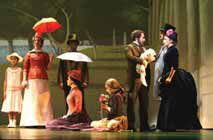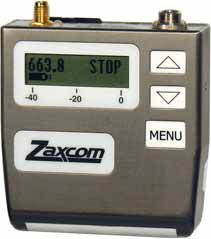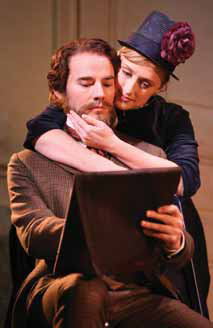When Sunday in the Park with George came to the Roundabout Theatre Company’s Studio 54 in New York following a very successful run in London’s West End, it delivered more than an award-winning cast and production; the play also brought the firstknown use of digital wireless microphones to a major production on a New York Broadway stage.
The American premiere of the new, five-time Olivier Award-winning production of the original Stephen Sondheim and James Lapine musical was performed at Studio 54 from January 25 through June 29,
By using level control systems to handle the routing of audio throughout the theater, along with a virtual run acoustic system, Masque Sound and Orbital Sound were able to tailor the acoustics to specific sections of the auditorium. (Photo Credit: Joan Marcus) with close direction from two audio powerhouses: New Jersey-based Masque Sound and U.K.-based Orbital Sound. This critically acclaimed production received nine Tony Award nominations, including a nomination for “best sound design” for Orbital Sound’s Sebastian Frost, the creative director and sound designer for Sunday in the Park with George. A central — and, until now, unconventional — part of Frost’s concept for the production’s sound design was the use of Zaxcom’s TRX900 wireless microphone systems.
“I was blown away by the quality of the microphones when we first used them on Sunday in the Park with George in West End,” says Frost. “They are very stable systems and provide an open, natural sound. The Zaxcom systems have performed beautifully, providing us with a high level of control and the ability to create this feeling of intimacy throughout the entire auditorium here at Studio 54.”
One of the obstacles of a theatrical production at the infamous Studio 54 is overcoming some of the unique characteristics of the building. Since it’s an older venue that was originally a disco club, there are a lot of hard surfaces that can create problems with audio reverberation throughout the room.
“One of the bigger challenges in working at Studio 54 has been creating a robust, yet intimate sound, particularly with a small orchestra that is set off to the side instead of in a pit,” adds Frost. “By using level control systems to handle the routing of audio throughout the theater, along with a virtual run acoustic system, we were able to tailor the acoustics to specific sections of the auditorium.”
Precise control over the wireless signals also allowed Frost to manipulate the audio to suit various scenes in the play. While most scenes required a softer, more natural sound than Studio 54 naturally provides, this was not always the case. For example, during a scene in Act II, the lead characters are presenting at an art gallery. The production staff was able to use the Zaxcom system to give a harder, reflective quality to the sound during this scene, giving the audience the experience of being right there in a large, open room along with the characters.
The benefits of the Zaxcom systems are far-reaching. In addition to providing superior control, Frost also reports very wide frequency response, superior RF stability, and no companding or compression. And because the system is more resilient to frequency interference than analog systems, the Zaxcom microphones require less spacing between transmitters. This lessens the need for production staff to coordinate with other Broadway shows that are on stage at the same time and are a possible source of audio interference.
Masque Sound, who was contracted by Roundabout Theater to handle audio for the New York production, sub-hired the Zaxcom systems from Orbital Sound. The system included support for 16 audio tracks: two from Daniel Evans who played the lead character, George, and 14 among the other cast members.

Roundabout Theatre Company’s Sunday In the Park With George used Zaxcom’s TRX900 digital wireless microphone systems. (Photo Credit: Joan Marcus)
Each of these actors had a transmitter body pack that would send the audio signals from the wireless microphones into a Yamaha PM5-D mixing console. This console then linked into an extensive digital processing system with technologies from a number of manufacturers to support various reverbs, digital delays, and signal routing to Meyer and Tannoy speakers. A control and playback system interacted with all audio systems and additionally triggered some of the stage lighting.
“The Broadway community is typically rooted in tradition and slow to change, so while much of the audio industry has already moved to digital, there’s still a lot of affection for analog on-stage,” says Scott Kalata, Masque Sound’s director of sales and services. “For this reason, the use of the digital wireless microphones was, for some, a leap of faith. Nonetheless, the Zaxcom system performed flawlessly. We didn’t have a single problem throughout the show’s 22-week run, and that’s exactly the type of long-term stability for which Broadway personnel are looking.
“For Masque Sound, digital wireless microphones are clearly the final frontier in the digital audio revolution,” adds Kalata. “The Zaxcom systems are exactly the type of cutting-edge technology that Masque Sound embraces — not simply because they are progressive company, but because at the end of the day, they provide excellent sound, are extremely reliable, and are easy for the customer to operate. We’ve seen considerable interest from other sound designers who are now taking a very close look at this technology.”

Roundabout Theatre Company’s Sunday In the Park With George used Zaxcom’s TRX900 digital wireless microphone systems. (Photo Credit: Joan Marcus)
- “I was so impressed with the quality and performance of the Zaxcom system that I’ve used it on several shows since,” concludes Frost. “It was very easy to achieve good coverage of the stage, and the quality of the sound was phenomenal.”










